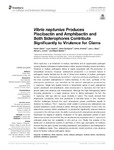Mostrar o rexistro simple do ítem
Vibrio neptunius Produces Piscibactin and Amphibactin and Both Siderophores Contribute Significantly to Virulence for Clams
| dc.contributor.author | Galvis, Fabián | |
| dc.contributor.author | Ageitos, Lucía | |
| dc.contributor.author | Rodríguez, Jaime | |
| dc.contributor.author | Jiménez, Carlos | |
| dc.contributor.author | Barja, Juan L. | |
| dc.contributor.author | Lemos, Manuel L. | |
| dc.contributor.author | Balado, Miguel | |
| dc.date.accessioned | 2022-03-11T14:42:35Z | |
| dc.date.available | 2022-03-11T14:42:35Z | |
| dc.date.issued | 2021-10-25 | |
| dc.identifier.citation | Galvis F, Ageitos L, Rodríguez J, Jiménez C, Barja JL, Lemos ML and Balado M (2021) Vibrio neptunius Produces Piscibactin and Amphibactin and Both Siderophores Contribute Significantly to Virulence for Clams. Front. Cell. Infect. Microbiol. 11:750567. doi: 10.3389/fcimb.2021.750567 | es_ES |
| dc.identifier.issn | 2235-2988 | |
| dc.identifier.uri | http://hdl.handle.net/2183/29972 | |
| dc.description.abstract | [Abstract] Vibrio neptunius is an inhabitant of mollusc microbiota and an opportunistic pathogen causing disease outbreaks in marine bivalve mollusc species including oysters and clams. Virulence of mollusc pathogenic vibrios is mainly associated with the production of extracellular products. However, siderophore production is a common feature in pathogenic marine bacteria but its role in fitness and virulence of mollusc pathogens remains unknown. We previously found that V. neptunius produces amphibactin, one of the most abundant siderophores in marine microbes. In this work, synthesis of the siderophore piscibactin was identified as the second siderophore produced by V. neptunius. Single and double mutants in biosynthetic genes of each siderophore system, piscibactin and amphibactin, were constructed in V. neptunius and their role in growth ability and virulence was characterized. Although the High Pathogenicity Island encoding piscibactin is a major virulence factor in vibrios pathogenic for fish, the V. neptunius wild type did not cause mortality in turbot. The results showed that amphibactin contributes more than piscibactin to bacterial fitness in vitro. However, infection challenges showed that each siderophore system contributes equally to virulence for molluscs. The V. neptunius strain unable to produce any siderophore was severely impaired to cause vibriosis in clams. Although the inactivation of one of the two siderophore systems (either amphibactin or piscibactin) significantly reduced virulence compared to the wild type strain, the ability to produce both siderophores simultaneously maximised the degree of virulence. Evaluation of the gene expression pattern of each siderophore system showed that they are simultaneously expressed when V. neptunius is cultivated under low iron availability in vitro and ex vivo. Finally, the analysis of the distribution of siderophore systems in genomes of Vibrio spp. pathogenic for molluscs showed that the gene clusters encoding amphibactin and piscibactin are widespread in the Coralliilyticus clade. Thus, siderophore production would constitute a key virulence factor for bivalve molluscs pathogenic vibrios. | es_ES |
| dc.description.sponsorship | This work was supported by grants AGL2017-86183-R (AEI/FEDER, EU), RTI2018-093634-B-C21/C22 (AEI/FEDER, EU) and PID2019-103891RJ-100 (AEI) from the State Agency for Research (AEI) of Spain. AGL2017-86183-R and RTI2018-093634-B-C21/C22 were co-funded by the FEDER Programme from the European Union. Work in University of Santiago de Compostela was also supported by grants GRC2018/018 and 2021-CP112, and in University of A Coruña by grant GRC2018/039 from Xunta de Galicia (Spain). FG was financed with a fellowship ‘Programa de formación de recurso humano de alto nivel doctorado en el exterior’ granted by Colciencias and the government of Norte de Santander, Colombia. LA was financed with a fellowship (ED481A-2019/081) from Xunta de Galicia (Spain), co-financed by ESF (European Social Fund) | es_ES |
| dc.description.sponsorship | Xunta de Galicia; GRC2018/018 | es_ES |
| dc.description.sponsorship | Xunta de Galicia; 2021-CP112 | es_ES |
| dc.description.sponsorship | Xunta de Galicia; GRC2018/039 | es_ES |
| dc.description.sponsorship | Xunta de Galicia; ED481A-2019/081 | es_ES |
| dc.language.iso | eng | es_ES |
| dc.publisher | Frontiers | es_ES |
| dc.relation | info:eu-repo/grantAgreement/AEI/Plan Estatal de Investigación Científica y Técnica y de Innovación 2017-2020/AGL2017-86183-R/ES/POBLACIONES MICROBIANAS Y CONTROL DE PATOGENOS EN CRIADERO DE BIVALVOS. HACIA EL CRIADERO DEL FUTURO/ | |
| dc.relation | info:eu-repo/grantAgreement/AEI/Plan Estatal de Investigación Científica y Técnica y de Innovación 2017-2020/RTI2018-093634-B-C21/ES/FACTORES DE VIRULENCIA BACTERIANOS COMO DIANAS TERAPEUTICAS EN PECES: CARACTERIZACION DE SIDEROFOROS Y DESARROLLO DE NUEVOS TRATAMIENTOS CONTRA FORUNCULOSIS Y TENACIBACULOSIS/ | |
| dc.relation | info:eu-repo/grantAgreement/AEI/Plan Estatal de Investigación Científica y Técnica y de Innovación 2017-2020/RTI2018-093634-B-C22/ES/FACTORES DE VIRULENCIA BACTERIANOS COMO DIANAS TERAPEUTICAS EN PECES: CARACTERIZACION DE SIDEROFOROS Y DESARROLLO DE NUEVOS TRATAMIENTOS CONTRA FORUNCULOSIS Y TENACIBACULOSIS/ | |
| dc.relation | info:eu-repo/grantAgreement/AEI/Plan Estatal de Investigación Científica y Técnica y de Innovación 2017-2020/PID2019-103891RJ-I00/ES/ADAPTACION TRANSCRIPCIONAL DE VIBRIO ANGUILLARUM TRAS LA ADQUISICION DE LA ISLA DE PATOGENICIDAD IRP-HPI: APLICACIONES PARA LA OPTIMIZACION DE VACUNAS FRENTE A LA VIBRIOSIS/ | |
| dc.relation.uri | https://doi.org/10.3389/fcimb.2021.750567 | es_ES |
| dc.rights | Atribución 4.0 Internacional | es_ES |
| dc.rights.uri | http://creativecommons.org/licenses/by/4.0/ | * |
| dc.subject | Coralliilyticus | es_ES |
| dc.subject | Vibrio neptunius | es_ES |
| dc.subject | Bivalve molluscs pathogens | es_ES |
| dc.subject | Virulence factors | es_ES |
| dc.subject | Siderophores | es_ES |
| dc.subject | Piscibactin | es_ES |
| dc.subject | Amphibactin | es_ES |
| dc.subject | Aquaculture | es_ES |
| dc.title | Vibrio neptunius Produces Piscibactin and Amphibactin and Both Siderophores Contribute Significantly to Virulence for Clams | es_ES |
| dc.type | info:eu-repo/semantics/article | es_ES |
| dc.rights.access | info:eu-repo/semantics/openAccess | es_ES |
| UDC.journalTitle | Frontiers in Cellular and Infection Microbiology | es_ES |
| UDC.volume | 11 | es_ES |
| UDC.startPage | 750567 | es_ES |






